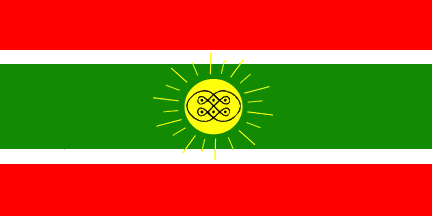.gif) Image by
António
Martins-Tuválkin, 29 Mar 2024
Image by
António
Martins-Tuválkin, 29 Mar 2024
Last modified: 2025-05-24 by bruce berry
Keywords: angola | unita | black rooster |
Links: FOTW homepage |
search |
disclaimer and copyright |
write us |
mirrors
 Image by
António
Martins-Tuválkin, 29 Mar 2024
See also:
Image by
António
Martins-Tuválkin, 29 Mar 2024
See also:
A Portuguese journalist recently shed more light on this movement seeking
autonomy from Angola.
The Movement of the Protectorate of Lunda Tchokwe (Movimento do Protetorado
de Lunda Tchokwe - MPLT / MPRLT) was founded in 2006. Its name refers
to the protectorate established in the late 19th century by Portugal over part
of inner Angola - more or less all of the eastern half of
the country - that could not be actually settled. Portugal signed treaties
(between 1885 and 1894) with several sovereign tribes, which the MPLT claims to
represent now. The MPLT claims that this territory was never administratively
part of colonial Angola and was therefore was illegally incorporated to
independent Angola in 1975.
In 2019, during the official visit of the President of Portugal to Angola, the
MPLT released statement with some very ambiguous wording.
"Lunda Tchokwe deserves independence by natural law and, juridical, by the
protectorate treaties signed by the Lunda ancestors with the Portuguese, that is
autonomy similar to that granted to Madeira and the Azores by the Portugal."
The MPLT rejects violence and armed struggle. On 30 January 2021, between 6 and
15 civilians were killed during a street demonstration, which motivated a police
inquiry and a strong protest from the Roman Catholic Church. The authorities
claimed that the demonstrators had attacked a police squad, which was strongly
denied by the MPLT.
The MPLT maintains an ambiguous stance regarding Portugal. The movement
vehemently criticizes Portugal's colonial history, but asks the Portuguese
government to "correct the injustice represented by the integration of the Lunda
territory into Angola and to respect the treaties signed with the ancestors".
Filipe d'Avillez, (Renascença) 01 February 2021sent by Ivan Sache,
05 Feb 2021
I have found on Wikipedia a reference to a new secessionist movement with a
flag in Angola. The United Kingdom of Lunda Tchokwe is a small movement claiming
eastern half of Angola (500 000 km2 and about two million people). The Lunda and the Tchokwe
are two related Bantu tribes. The traditional Tchokwe kingdom was conquered by
Portugal only around 1920. This struggle for independence (obviously doubtful)
is motivated by diamond mining in the area. The capital is Luena City. The
Tchokwe are known for their artisan woodcraft masks.
The flag is red-white-green-white-red (ratio 3:1:4:1:3) with a
yellow sun containing a black ornamental emblem in the centre of the middle stripe.
Jakub Grombíř, 18 June 2011
Here are some images from the defunct blog above, showing diagrammatic flag
images and a photos of flags in use, incl. one taken in late 2014:
http://1.bp.blogspot.com/.../Bandeira.jpg
http://1.bp.blogspot.com/.../IMG_0186.JPG
http://2.bp.blogspot.com/.../JMateus.JPG
http://1.bp.blogspot.com/.../Bandeira_Lunda.jpg
http://2.bp.blogspot.com/.../AfricaLUNDA.jpg
The flag shown is clearly 3:5 or thereabouts, not more oblong, and the height
of the white stripes is more than half that of the red ones. The specs given by
Jakub Grombíř and illustrated by Jason Saber must come from a different source,
attesting (or at least suggesting) variations in the exact measures used in flag
design and production - which is not surprising.
António
Martins-Tuválkin, 29 Mar 2024
.gif) Image by
António
Martins-Tuválkin, 29 Mar 2024
Image by
António
Martins-Tuválkin, 29 Mar 2024
The central emblem seems to be an example of lusona, a traditional ideographic quasi-writing artform, used also in beadwork and embroidery - see also https://en.wikipedia.org/wiki/Lusona
On the mentioned 2014 photo it can be seen how the strict geometric accuracy of the black lines and dots (lusona is traditionally very finicky about these details) contrasts sharply with the asymmetric and haphazard way the sunbeams were added around the central disc onto the green and white areas.
António Martins-Tuválkin, 29 Mar 2024
This particular device is the traditional lusona symbol for antelope
footprint, as stated in an English language children activities book:
https://misfitsandheroes.wordpress.com/wp-content/uploads/2011/11/sona-3.jpg
It is used in temporary sand drawings, which accompany oral tradition
storytelling.
António
Martins-Tuválkin, 18 Jan 2025